Tekpower TP3005D-3 Bench Supply Review
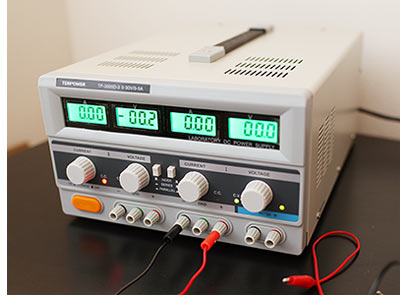 I
was in the market for a proper DC bench power supply for testing some of
my circuits instead of using batteries and regulators or variacs, so I
decided to look around for one without costing too much. I eventually
went for a Tekpower TP3005D-3 which I got on Amazon for $185 shipped.
The TP3005D-3 is a basic 3-channel 30V 5A DC bench power supply, but is
it any good? Let's find out in this quick review! I
was in the market for a proper DC bench power supply for testing some of
my circuits instead of using batteries and regulators or variacs, so I
decided to look around for one without costing too much. I eventually
went for a Tekpower TP3005D-3 which I got on Amazon for $185 shipped.
The TP3005D-3 is a basic 3-channel 30V 5A DC bench power supply, but is
it any good? Let's find out in this quick review!
Page Contents
1. Searching
for a Supply
2. Electrical Performance
3. Internal Construction
4. Conclusion
Specifications
- Input 110VAC non-switchable
- Outputs: 2x 30V 5A + 5V 3A
- CV Regulation: 0.01% +- 5mV
- CC Regulation: 0.01% +- 6mA
- Ripple / Noise: < 20mVpp, <50mApp
- Volts: LCD + 1% +- 2 digits
- Current: LCD + 2% +- 2 digits
- Size: 360x 265 x 165mm
- 5V Output: <10mVpp, 5V+-3%
In this page I will describe the motivations and
reasoning behind my choice for this supply, what my expectations
were, its general electrical performance, internal construction, and
what I think of the supply overall.
23 Nov 2014
1. Searching for a DC
Supply
When I started looking for a power supply, the idea I
had in my mind was a Dual Channel 30V 3A linear power supply I used
before in my school's lab, which had separate controls for constant
current and constant voltage output. I do not know what brand it was,
but it was very nice to use. In addition, I often work with relatively
high-power projects, so I knew I wanted one with reasonably high power
capability. Finally, I didn't want to break the bank for the supply.
With this in mind, I came up with a checklist and began my search.
DC Power Supply Requirements
- At least dual channel 30V 3A output
- Cost at most $200
- Capability to parallel / series outputs
- Isolated
- Preferably with a toroid transformer
- No need for super high precision
I knew the high quality HP / Agilent power supplies were
firmly out of my budget. However, having had a fantastic experience with
my Rigol oscilloscope, I went to check out what Rigol had to offer.
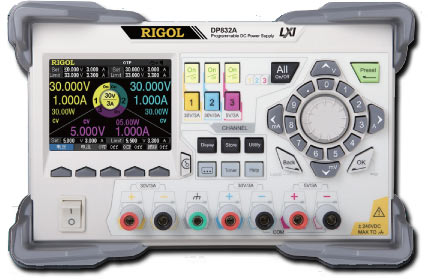
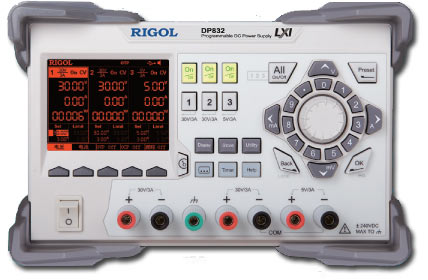
Rigol power supplies - $800 for the DP832A and $450 for the DP832, going
up to $980(images from rigolna.com).
These power supplies are excellent power supplies, such
as the entry level precision programmable power supply DP832 (195W
Triple output), or the higher performance DP832A. Dave Jones from the
EEVblog gave an excellent
video review of Rigol's power supply offerings, but the cost of half
a grand put it firmly out of my budget. I also looked at cheaper
alternatives such as BKprecision, Instek, etc, but it looked like I
wouldn't be able to get any reasonable dual channel supply for anywhere
near $200. I also browsed Ebay, but the heavy nature of power supplies
mean that shipping would be a significant cost of any supply.
Eventually I looked on Amazon.com and I found a bunch of
of supplies for reasonable prices and free shipping!
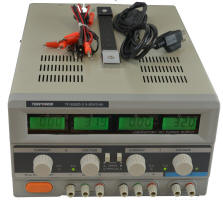
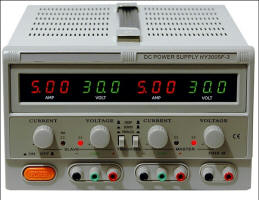
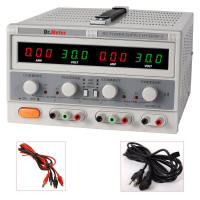
Tekpower TP3005D-3, Mastech HY3005F-3 and Dr. Meter HY3005F-3 Power
Supplies (images from amazon.com).
They were all selling for between $180 to $190, and were
the three main 3-channel power supplies on Amazon. I knew I could get
the half sized single channel supplies for about $100, but I knew I
wanted at least two channels, so these three look like they would fit
the bill. I also knew that I should revise my expectations given that
these are certainly very similar cheap-chinese PSUs, and therefore I
wasn't expecting much from them in terms of performance and precision,
but that is ok for my purpose. If you are working with more sensitive
low-power circuits, the Rigols look like the way to go.
The power supply that had the best review on Amazon was
the
Mastech HY3005F-3 (they are all 30V 5A supplies), but it strangely
had the image of the Tekpower on the page! A quick read in the comments
suggest that they were actually selling the supply in the middle in the
photos above. In fact, the supply was recently re-branded as Dr. Meter,
and Amazon was now shipping the supply as shown on the right!
I was a bit annoyed by this, mostly because the
front-panel of the supply looked very cheap and ugly, but I did a search
on the internet to see if anyone had done a review or teardown. Sure
enough, I found a review on the
EEVblog forum.
The review was by jamesp15 and he/she was nice enough to
include some good photographs of the Mastech HY3005F-3 and its internal
guts. Lets take a look.
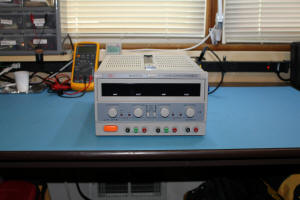
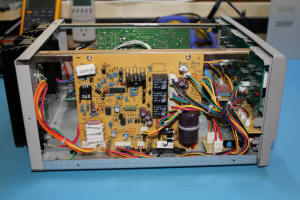
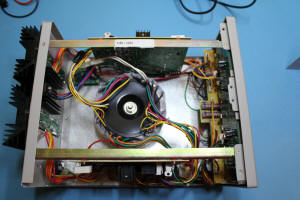
Mastech HY3005F-3 and its internals - Photographs by jamesp15 from the
EEVblog Forum
Immediately, a few main things stood out to me:
- Surprised to see a toroidal transformer, which is
usually more expensive, but more compact and with less EMI. Was
expecting a cheap square transformer!
- Had protruding heat-sinks on the back with 6 2N3055 TO-3 transistors
on the back, as expected
- Circuit boards basically made of through-hole parts, single sided,
paper/resin boards (not fiberglass) and generally quite ugly (expected)
- Cheap galvanized metal construction
Overall it was exactly what I had expected for a $200
chinese power supply unit, though to be honest I was quite disappointed
at the poor quality of the through-hole boards and the overall cheapness
oozing from the cheap metal box. Contrast this with how beautiful the
Rigols and Agilents look inside. It looked like almost all of the cheap
30V 3/5A power supplies on the internet were essentially identical but
rebadged versions of this supply and probably all rolled out from the
same factory, so realized I didn't really have much of a choice though.
So I thought I might as well try to find at least one
with a less cheap looking front panel, i.e. the original Tekpower.
Fortunately, I found that Kaito-usa was indeed selling that original
TekpowerTP3005D-3 on
Amazon right here! I couldn't find if tekpower was a legitimate
brand or not, but it did seem that there were variants of the
TP3005D around the internet!
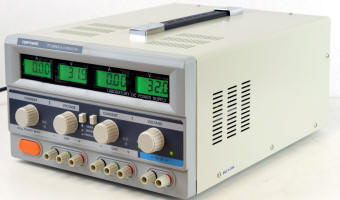
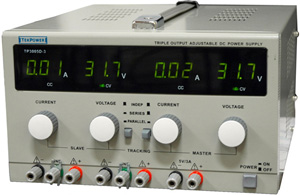
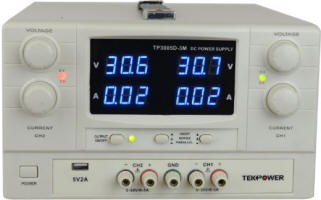
Different power supplies, same name! Go figure! The one for sale on
Amazon is on the left.
Very puzzling. But one thing stood out to me about the
Tekpower versus the Mastech/Dr. Meter supplies. It had a completely
different construction due to the fact there were no heat-sinks at the
back and much less holes in the case, meaning that this must have a
completely different cooling mechanism. This made me think that the
people who made this thing must have put a bit more thought into this,
and must be a different design from the Mastech.
So I decided to take a risk and get the Tekpower!
2. Electrical Performance
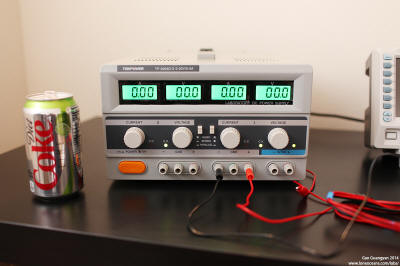
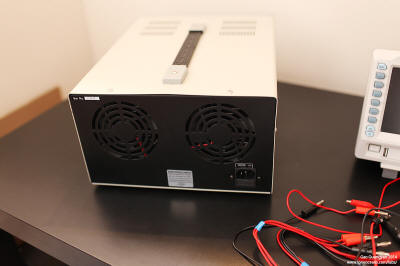
The Tekpower TP3005D-3, front and back. Note the bright
electro-luminescent displays and dual 80mm cooling fans on the
back.
The power supply arrived in typical Amazon style, in two
boxes. It was very well packaged though, so I have no complaints at all.
The power supply actually came in much nicer quality that expected and I
really like the matte powder-coat they had on the entire package,
instead of the usual cheap-looking glossy finish for cheap products. I
it did make a good first impression. The next thing I noticed was that
it didn't have a 220/240V switch on the power input, which was a bit
disappointing. Another thing was I was concerned about was the
poor-looking quality of the LCD display, but it turned out that the
backlight was a very nice green electro-luminescent display and not a
cheap LED, so that was a nice touch. The display does become a bit more
difficult to read from above though, so that's one limitation. I'll talk
about the construction in the next section - let's see its electrical
performance first!
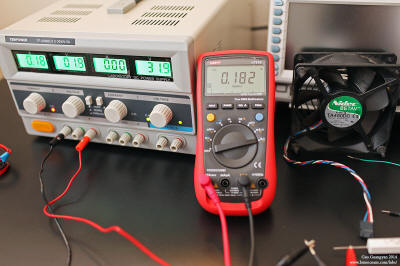
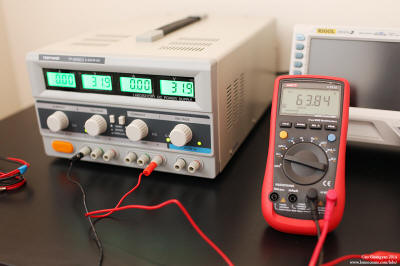
I checked all three outputs with a variety of voltages,
currents and loads, as well as the maximum and minimum outputs. In
short, everything was within specification, expect that it struggled to
provide the maximum 30V at 5A. Here I am using my Uni-T UT61E
multi-meter, which in my opinion is one of the best meters you can get
for only $40 shipped! Excellent multi-meter for the price.
The output for each channel goes up to about 31.8V or so
per channel with a maximum combined for 63.84V with no load in series..
The 5V rail read about 5.030-5.040V with no / small load, dropping to
5.012V at 500mA, well within the 3% quoted accuracy. The voltage and
current readings were basically within the least significant digit,
again well within the specification of 2 counts, and reasonably
consistent across different loads to the last significant digit.
To be honest, I wasn't expecting the supply to
actually be able to supply 30V at 5A, because this is a huge 150W
power channel. However, I was pleasantly surprised that, using whatever
power resistors I had on hand, that it was actually able to supply at
least 5.2A at 29.6V! That's more than what I realistically expected and
more
than enough for what most people would need. I wasn't able to test both
channels at max load at the moment, but I'll update this page as I
continue testing it. The voltage and current
readouts are basically working as expected.
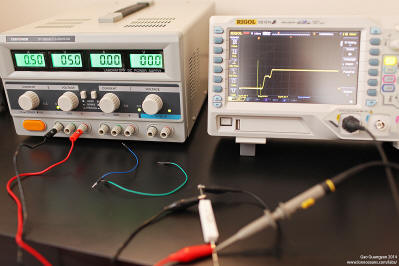
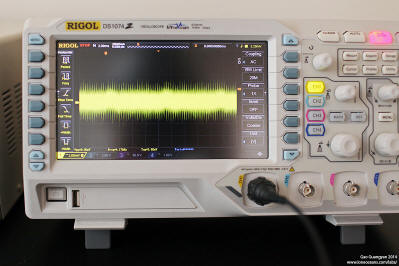
Next I tested shoot-through and transients during switch
on and off. Performance was quite similar for a variety of different
voltages and loads, with a small transient at the beginning ranging from
2 to 8V or so, and usually a stepped response up to the set voltage.
That said, if I was working on a critical circuit, I would probably just
disconnect the circuit before turning it on. The transients tend to
decrease with the larger load. Turn off transients are similarly small
or smaller. As for shoot-through, the supply tended to take a
step-function before going to the correct voltage, and the only
shoot-through I did see was perhaps around 10V with no load where it
shot to 11V before coming down to 10, but this disappeared with a load.
How about noise and regulation? I found that the supply
was reasonably consistent through the range with differing loads,
dropping slightly with a heavier load, but they were all hovering around
8mVp-p at 20Mhz bandwidth, which is well within the 20mVp-p
specification. Good enough! (More tests to come soon as I use it more
and more).
Now time to take it apart!
3. Internal Construction
I talked about the good first impression of the
product, but lets take a look in more detail. After unscrewing
something like 10 screws, the innards are revealed!
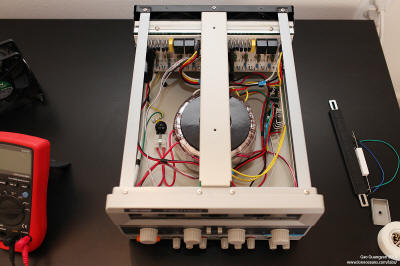
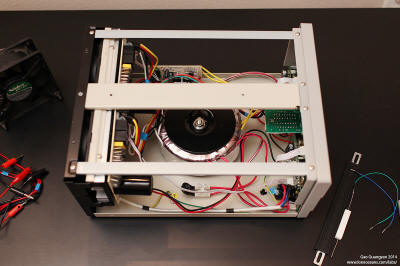
Wow, completely different construction to the Mastech! A
few first impressions that stood out to me:
- Nice big toroid transformer!
- Completely powder-coated inside, much nicer finish than simply using
nickel-plated / galvanized steel in the Mastech
- Very different power-circuit construction with active cooling
(compared to the Mastech/Dr. Meter)
- Besides the power boards with large components, everything else is SMD
on nice boards
- Generally well constructed with heat-shrink cabling, input protection,
rubber boots on connections
- No external heat-sink with sharp fins - makes transportation much
easier
One thing I wanted to point out was the use of the nice
metal rib at the top of the case where the handle attaches to. This is
much more sturdy in my opinion than the Mastech construction where the
handle looks like it's just being supported by the thin metal shell,
which will invariably flex since the supply is quite heavy. Overall,
weight balance is excellent.
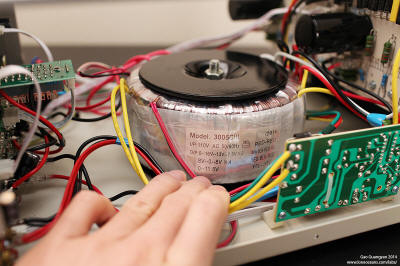
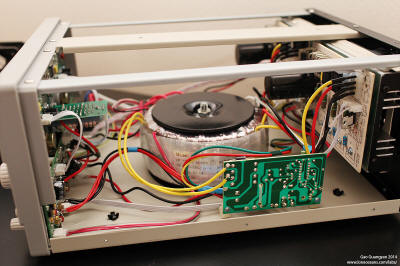
Take a look at this nice big toroid! It looks like a
300VA toroid made in 2014. Unfortunately it is a single 110V
transformer, so no luck in converting it to run on 220/240V. However,
there looks like there is ample space inside to mount a 300VA 240V to
110V transformer...
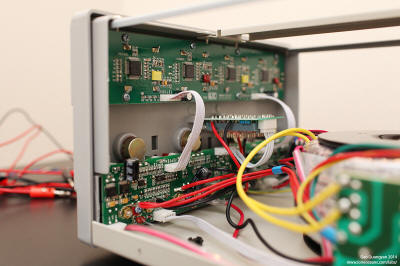
Lets take a closer look at the front-panel boards.
This was very surprising because it looked like really high quality
double sided SMD boards, one for the main controls and the other for the
display. It was fun to see how they had one controller individually driving
each LCD panel. This connects neatly via ribbon cables to the main
control board, which contained a smattering of TI Op-amps such as the
usual LM324 and OP07C low-offset voltage operational amplifiers. It also
looks like the crappy single turn potentiometers will be simple to
replace with proper multi-turn pots, and is a mod that I plan to be
doing in the near future! Looking great so far.
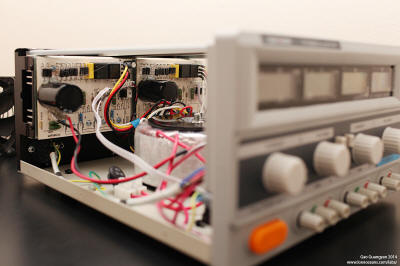
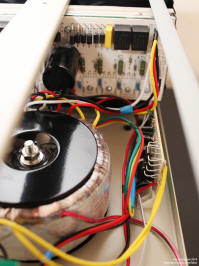
Lets now look at the back boards and a daughter-board,
which house the power circuits for each channel + the 5V rail, regulated
by a LM723CM voltage regulator. The boards are also populated with Hong-Fa
JQC-3FF sub-miniature relays with 15A switching capability, and look to
be on-par for the course. The two huge filter capacitors are 63V 6800uF.
All caps seem to be 'C' branded 105C, but nothing I recognize.
Otherwise, reasonably neat and clean construction.
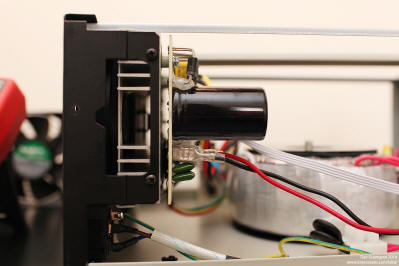
One thing I really quite liked was the nice extruded
heat-sink with a total of 9 TIP3055 transistors, with a thermocouple
which turns on the fans once it hits 50C. Each channel uses 4 of these
TO-247 transistors in parallel with the 5V rail using one. While I don't
really like how the big capacitors are just sitting there sideways, they
have gone to the effort to at least hot-glue them down. Also note the
proper extruded aluminium heat-sink, not some cheap folded sheet-metal
ones.
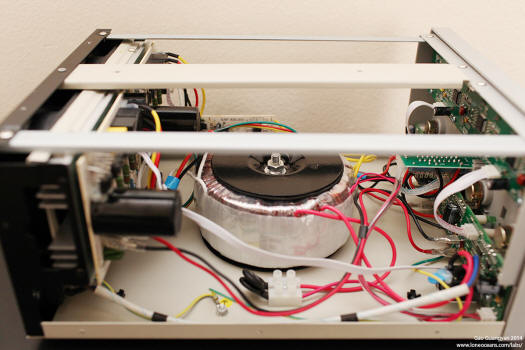
Overall, I was pleasantly surprised with the higher
quality construction which I was certainly not expecting! It certainly
has room for some simple modifications such as swapping out the crappy
potentiometers with multi-turn ones for much more accurate control.
Definitely a completely different product from the Mastech! So what do
you think?
4. Conclusion
To summarize, the Tekpower TP3005D-3 (at least
the one pictured here!) is a completely different product from
the similar-looking Mastech / Dr. Meter HY3005F. It has much
better internal construction, a nice big toroid transformer, and
measured ~8mVpp CV regulation (well within the 20mVpp
specification) at 20Mhz bandwidth. Output goes up to 32V per
channel, and uses a generous amount of TO247 TIP3055 transistors
with a well-designed active cooling system. I have tested it at
up to 5.2A 29.6V per channel, so it looks to be able to supply
at least 150W per channel (haven't been able to test maximum
load for the entire device yet). Negligible overshoot (if
any) which basically disappears with any load, but I would still
be careful with connecting my circuits and toggling the on-off
button just to be safe.
The things I want to be improved the most would be a
selectable switch for 240V operation, and multi-turn potentiometers for
voltage / current control. Overall, much better than I had expected and
an excellent value compared to any other product for sub $200. For any
one looking for an affordable non-precision power supply, I will have to
recommend the
Tekpower; for anything else, probably a better idea to grab one of
the Rigols.
More to come soon as I continually update this page as I
test the power supply more.
Final Notes:
After buying this from Amazon, Kaito-USA (distributer)
included in the box a 1-yr warranty card as well as a note saying that
if I left a review on Amazon, they would send me a 'mysterious gift'! I
wrote a review on Amazon and I'll update this page when I receive their
'mysterious gift!'. I also plan to upgrade the front-knobs to something
better, so more to come soon!
Back to main page
(c) Gao Guangyan 2025
Contact: loneoceans [at] gmail [dot] com |

